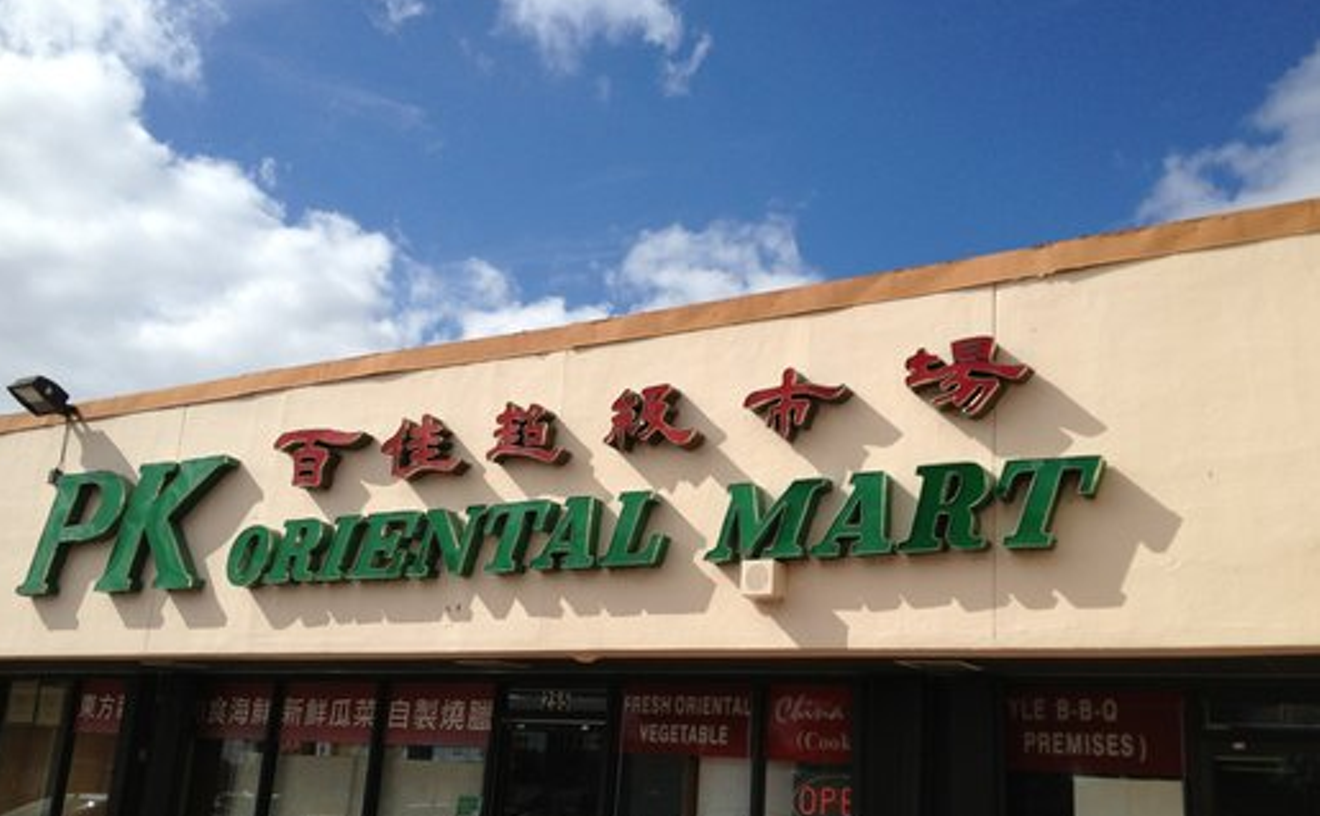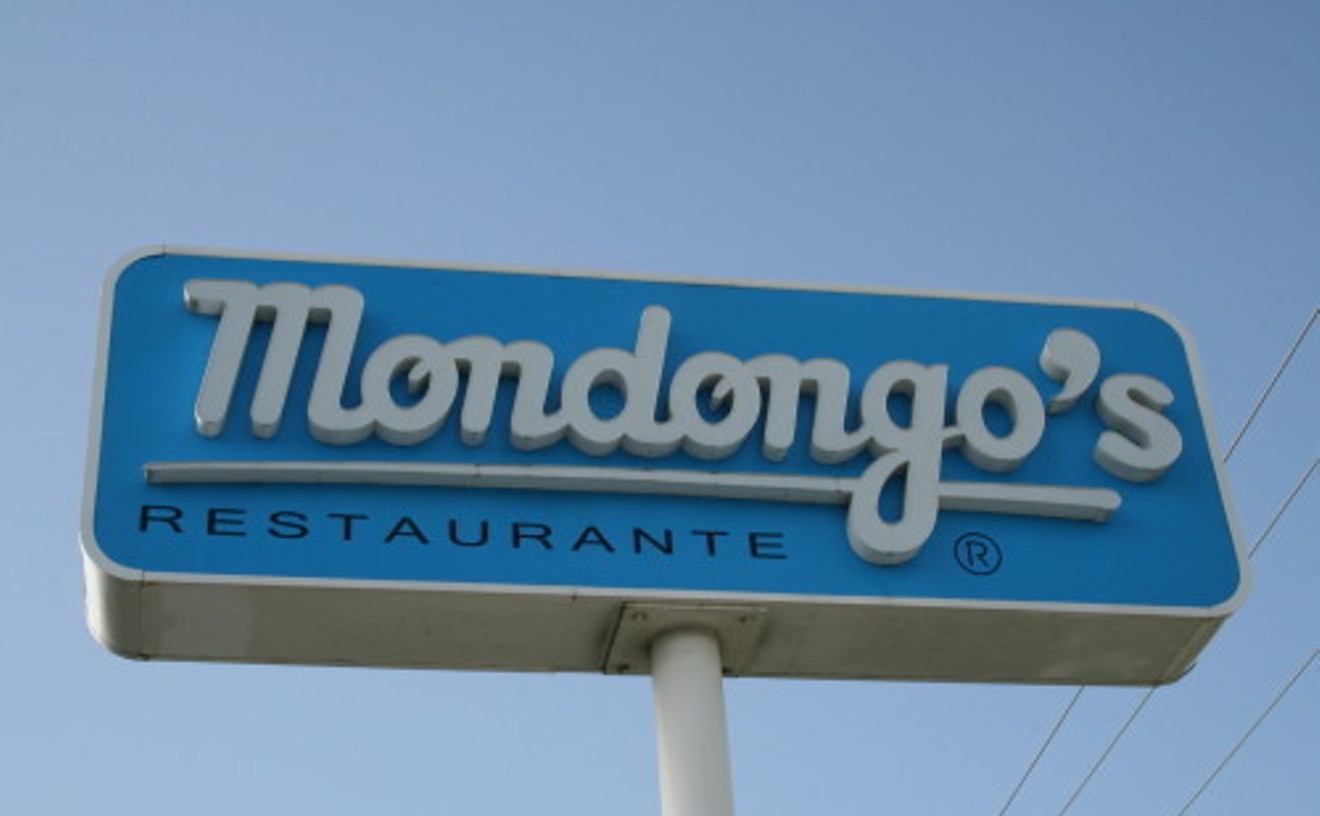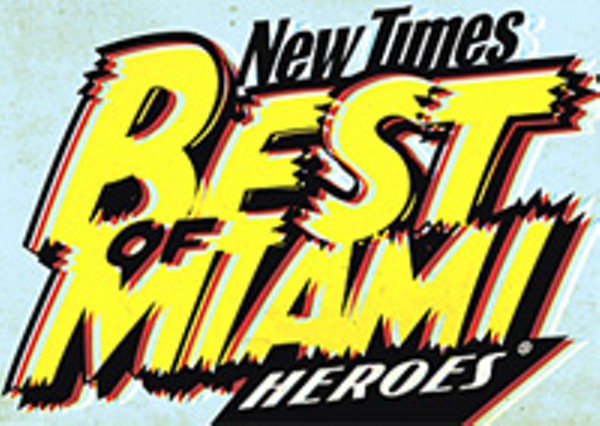Best Nicaraguan Restaurant
Yambo

Photo by billwisserphoto.com
Yambo stands out from the rest of the local fritanga pack for two major reasons: One, it's open 24 hours a day, seven days a week. Two, it looks like a Surrealist's fever-dream vision of a roadside souvenir shack. Yambo is as much, if not more, about the atmosphere as it is about the food. On the roofed terrace, folk art trinkets hang from and cover every possible surface — miniature guitars, hats, porcelain pots, even a mounted boar's head. An over-life-size knight statue guards the dark brown-tiled dining room. The tinny whine of a coin-operated pony ride sometimes drowns out the polkalike ballads emanating from an encyclopedic jukebox of Latin music.Virtually no English is spoken here, but anyone can order easily enough — customers walk down the length of a cafeteria-style counter, pointing at their selections, which are dutifully scooped onto a Styrofoam tray. Flesh-eaters will want to go for juicy, chewy chunks of skirt steak, or a whole snapper (both under $5), or crispy chicken taquitos ($3 for six). Vegetarians are even decently served — go for red beans and rice, any form of plantain, or repochetas — thin stacks of tortillas and cheese, a little like a quesadilla (most sides are $1.50). At the center of each table is a wooden vat of house-made hot sauce. The red mixture is addictive enough that during a recent visit, we spotted one patron ladling it into a Ziploc bag hidden in her purse. Unescorted females, or those put off by a small police presence, might want to skip visits during the wee hours. But diehard partiers take note: You can get a beer at almost any time here, provided you pour the contents of your bottle into one of the helpfully provided Styrofoam cups.
- 1643 SW First St., Miami, 33135 Map
- 305-649-0203
- www.facebook.com/yamborestaurant
Best Bakery
Delices de France French Bakery

As you pass the bistro-style tables outside of this bakery you'll see why it's worth the drive south. Upon entering — past the sign that states that all baking is done on premises, using only natural ingredients — an assortment of pastries and breads will leave you clueless as to what to buy. Because you won't want to pick just one thing from among the rich chocolate mousse cake, fruit tarts of several varieties, cream-filled doughnuts, cheese-filled breads, and more.If you've come craving sweets, try an eclair ($2.75). The puff pastry keeps its air and doesn't feel mushy, the way it can at some bakeries. It's topped by a line of chocolate that won't overwhelm the flavor of the thick filling. The mixed-fruit tart ($3.95) is another great choice, its crust buttery and crisp yet still soft. The cream is not overly sweet, and the arrangement of strawberries, blueberries, kiwi, peaches, and raspberries paint it beautifully.In the bread section you'll find croissants and baguettes with a variety of stuffings. Though the French might take offense, Miami natives will appreciate the blend of cultures that is the guava croissant ($1.95). If you prefer to feel like you're wandering through the streets of Paris, sample the pain au chocolat, a croissant bursting with chocolate, or just grab a mini baguette (50 cents) with your cafe au lait, and imagine away.
- 14453 S. Dixie Highway, Palmetto Bay, 33176 Map
- 305-256-9700
Best Peruvian Restaurant
El Meson del Paraiso

Peruvian food is not meant to be fancy, yet it seems that a new restaurant offering a frilly version of this cuisine opens every week. They garnish beans as if they were lobster bisque and stick mangoes in your ceviche. Next time you want some real Peruvian food, stop by El Meson del Paraiso. This tiny shop tucked into the side of a strip mall will provide you with an excellent meal; no need for a reservation. Open with the classic ceviche de pescado ($9.95), fresh white pieces of fish buried under a pile of finely sliced red onions and drenched in cilantro-speckled lime juice. It's served with the traditional sweet potato, cancha, and choclo, just like mom used to make. For the main course try lomo saltado ($10.95). The real potato French fries suck up every bit of expertly seasoned juice from tender chunks of beef. There's also seco de res ($9.95), which comes perfectly complemented with sides of rice and Peruvian white beans. A large selection of seafood plates highlights Peru's passion for coastal food ($9.95 to $14.95). Make sure to ask for lucuma ice cream for dessert (described for the rest of us as a "pink vanilla flavor"), or maybe a bavarois de guindones, a dessert made with egg whites and raisins.
- 12820 SW 120th St., Miami, 33186 Map
- 305-234-8210
Best Argentine Restaurant
Parrilla Liberty

Natalia Molina
When is a South Beach restaurant not a South Beach restaurantç When it's a modest little Argentine grill just a handful of blocks away from the gold-paved streets of Lincoln Road. Actually to call Parrilla Liberty modest is an understatement. But who caresç The food is good and plentiful, the ambiance is downright neighborly, and prices are low, low, low. Less than ten bucks gets you a hearty churrasco dinner with fries that put those served at the toniest steakhouses to shame. A few bucks more gets you an appetite-busting parrillada — blood sausage, chorizo, sweetbreads, short ribs, flank steak, and a choice of sides. Give me liberty or give me Parrilla Liberty.
- 609 Washington Ave., Miami Beach, 33139 Map
- 305-532-7599
- www.laparrillaliberty.com
Best Gelato
Coco Gelato

Gustavo Sidelnik was a young man in love when he first started making gelato. He had caught sight of a beautiful Italian maiden, Rosa, sitting at the counter of her father's gelateria. Sidelnik strolled in and begged the owner, Don Giuseppe, for a job. The old gelato-maker agreed. Sidelnik worked hard, learning the art of churning deliciously creamy confections in all sorts of flavors, while secretly yearning for the lovely Rosa ... until she ran off with some scoundrel named Bruno! Years later, in 1993 to be exact, Sidelnick came to Miami, where he opened the first Coco Gelato inside the CocoWalk mall. Everyone fell for Sidelnik's gelato. In addition to traditional flavors, he produced magnificent new ones that reflect Miami's Latin American and Caribbean influences. On the menu you will find tamarindo and guava right alongside bubblegum and dark mousse. (A small — two scoops — sells for $5.25.) Sidelnik has expanded his operations to include Miami International Airport, Bayside Marketplace, and South Beach. All four locations are open seven days a week from 10:00 a.m. to 10:00 p.m., except for the Washington Avenue location, which closes at midnight.
- 3015 Grand Ave., Coconut Grove, 33133 Map
- 305-444-2989
- www.cocogelato.com
Best Asian Grocery
PK Oriental Mart

Considering how few truly good authentic Chinese restaurants there are in Miami-Dade County, it is astonishing how many excellent Asian markets there are. And while a few, like Japanese Market on the 79th Street Causeway, specialize in the ingredients of a single country, most carry packaged products from a full range of eastern nations: China, Japan, Thailand, Vietnam, Indonesia, Malaysia, and the Philippines. At least a couple of these pan-Asian markets (notably Lucky, in Westchester, and Chung Hing, on NE 163rd Street) also carry an assortment of oriental veggies and fruits that matches PK's impressive produce department for variety, freshness, and display. What makes PK special is the small but scrumptious-looking glass counter on the far left side of the store, displaying the market's housemade Chinatown-style barbecue. Among the items hanging are glistening whole roast ducks and soy-marinated chickens, their skins dark and crispy, the meat within bursting with succulent juices. There are regulation reddish strips of regular roast pork, but also crispy pork — wonderfully moist meat capped with light, crunchy panko breading. And on Saturdays and Sundays only, you'll find barbecue spareribs, plus pei pa duck. (The latter bird is flattened, deep-fried crisp, and hung, a laborious process that renders out nearly all subcutaneous fat, while crisping the skin and concentrating the meat's flavor.) The 'cue runs $14 per large piece, which includes hoisin or soy dipping sauces, plus custom butchery by a tiny woman with a terrifying cleaver.
- 255 NE 167th St., North Miami, 33162 Map
- 305-654-9646
Best Brazilian Restaurant
Porcao Churrascaria

Brazil, like the United States, is a big-ass country. When you have a big-ass country, you generally have a cuisine that's all about the fat of the land. Every animal, plant, fruit, and vegetable should be abundantly heaped upon the plate of a big-ass country's big-ass meal.When you bring a big-ass country's cuisine to the U.S. (witness China, Mexico, India) we have the odd tendency of serving it up buffet style — putting no limits on whatever fat-of-the land meal is already being dished out. Nowehere is this truer than at Porcao, where salad, pork, lamb, and beef are boundless. Consider the $43 dinner price a ticket to meat land. The Brazilians know how to do it, after all. And at Porcao they do it right: real classy, with a nice view of the bay. Ah, sí.
- 801 Brickell Bay Dr., Miami, 33131 Map
- 305-373-2777
- www.riosus.com
Best Carry-Out Chinese/South
Peking One Chinese Restaurant

You wouldn't think there's much special about Peking One if you just pass by. It's a three-table takeout space with pink Formica walls, white tile, and a counter. Above the counter, the menu is a series of photographs of typical dishes, each on a flowered white plate surrounded by baby's breath and roses. You can see the boxes of Asian ingredients in the kitchen behind the register and hear the grill sizzle as a cook yells something in Chinese. Yet this dull exterior well conceals the tasty food that's being created inside.Among the chef's specials is General Tso's chicken, a staple at most Chinese restaurants. But Peking One makes it better. The chicken is as moist as can be and swims in a sweet-yet-spicy sauce garnished with crisp broccoli. Orange chicken is similar, but the subtle citrus flavors are perfectly balanced. Pepper steak, just like Peking One's other beef dishes, is tender and divinely spiced. And the good news goes beyond the flavors: Peking One is also pretty cheap. A "jumbo" portion of pork fried rice — three quarts — goes for $12.50. If you have a really large party, ask for the "mega" size ($30). If it's just you, lunch can cost under $5, and that includes a main dish, fried rice, and a soda.
- 16229 N. Kendall Dr., Kendall, 33196 Map
- 305-388-8816
Best Colombian Restaurant
Mondongo's

It may sound like the name of an Atari videogame hero, but the namesake stew at Mondongo's is a serious meal. Twelve bucks gets you a massive bowl of pork, potatoes, and peppers, with sides of rice and arepas. With its two Medellin restaurants doing booming business, Mondongo's has exported its popular paisa cuisine to Doral. Take your pick of typical dishes, including, appropriately enough, the Típico, a heaping platter of rice, beans, meat, eggs, plantains, chicharrones, and all kinds of tasty Ají sauces, for $11.25. It's a hard-core protein-and-carbs place with good cocktails, reasonable prices, and takeout, if that's your style.
- 3500 NW 87th Ave., Doral, 33172 Map
- 305-718-4977
- www.mondongos.com
Best Carry-Out Chinese/North
Bamboo Garden II

Little Garden secret: If you eat in, you get scrumptious ice cream for dessert. You also get brilliant service, bright surroundings, and damn good Chinese-American food. But the Garden's also the place for takeout — right on Biscayne, plenty of parking, and damn good Chinese-American food. The wonton noodles are tight and layered, the primo pork plentiful in dishes such as lo mein, the honey-garlic chicken battered better than any you'll find. The chef here clearly has confidence, and rightfully so. For example, unlike at most such places, the pork-fried rice is fried rice with pork rather than the typical toss-in-anything mélange/mess. Be sure to ask them to pack in some of the house mustard — it's tears-of-joy material. There are many reasons B.G. II is a repeat winner. The main one: damn good Chinese-American food.
- 13195 Biscayne Blvd., North Miami, 33181 Map
- 305-899-9902





